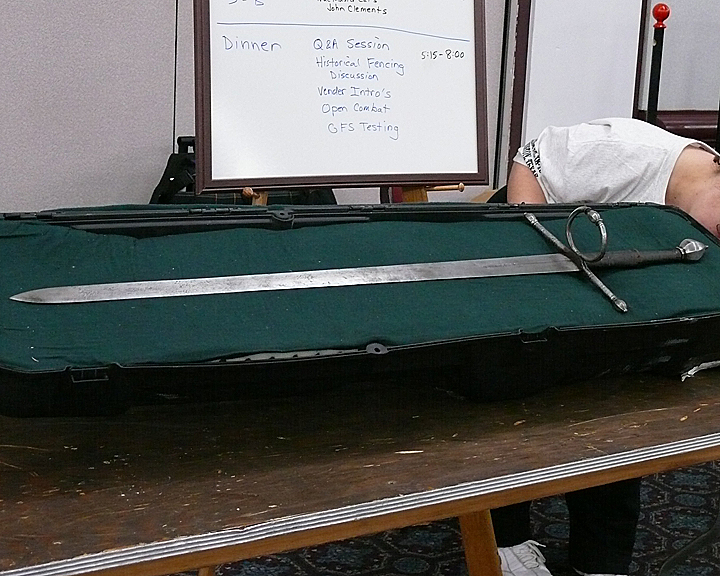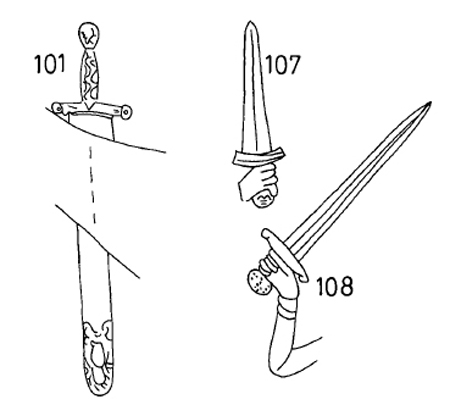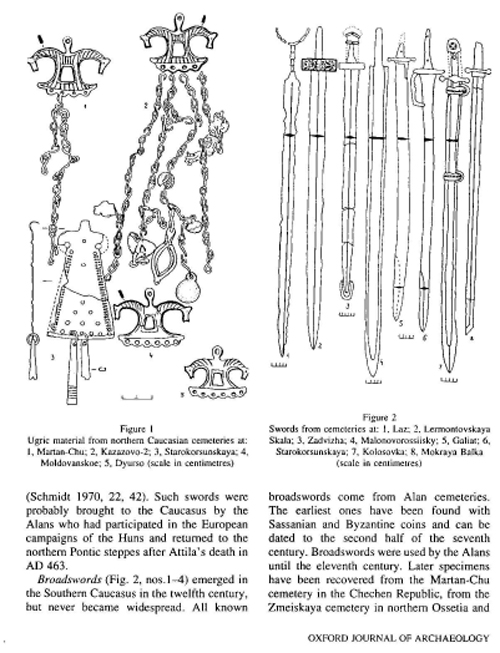| Author |
Message |
Greg Coffman

|
 Posted: Fri 15 Jan, 2010 9:27 am Post subject: Posted: Fri 15 Jan, 2010 9:27 am Post subject: |
 |
|
| W. Schütz wrote: | | It just looks like a very front heavy, very blade-thick and oddly shaped weapon. |
That's just how a lot of messers and falchions are, and many messers have longer handles like that.
As far as being oriental, the pommel looks like a fairly standard octagonal scent stopper. The cross looks fairly regular and European, too. The part of the cross that extends down the blade seems to end in a fleur-de-lis.
I'm sure that over time oriental style did influenced sword design in Europe. However, this particular sword is no more oriental than any other longsword, messer, or falchion or its day.
For the word of God is living and active. Sharper than any double-edged sword, it penetrates even to dividing soul and spirit, joints and marrow; it judges the thoughts and attitudes of the heart.
-Hebrews 4:12
|
|
  |
 |
Maurizio D'Angelo

|
 Posted: Fri 15 Jan, 2010 11:59 am Post subject: Posted: Fri 15 Jan, 2010 11:59 am Post subject: |
 |
|
I had enlarged the photo, not round, and even a little 'squashed. So do not know. If it had been as I thought, I think that would be of oriental origin.
It would be a great discovery for me, see the guards like those in Europe, no-Mediterranean area .
All those that I saw were of eastern origin.
Also know the date, it would be important to me.
Otherwise, I do not agree with you.
P.M.
photos added after
 Attachment: 17.47 KB Attachment: 17.47 KB

Ciao
Maurizio
Last edited by Maurizio D'Angelo on Sat 16 Jan, 2010 9:16 am; edited 2 times in total
|
|
   |
 |
Jan J.P. Koerni

Location: den haag Joined: 10 Jun 2009
Posts: 8
|
 Posted: Fri 15 Jan, 2010 2:37 pm Post subject: Re: van der Weyden Falchion - a soldiers or executioners too Posted: Fri 15 Jan, 2010 2:37 pm Post subject: Re: van der Weyden Falchion - a soldiers or executioners too |
 |
|
Getting one for reenactment is definitely a good one
Its works very well close-up
Just make sure that the one you get is the right lenght (mine got a blade lenght of 64 cm)
To short and it gets very difficult to get in close, to long and you've got the problem of scraping along the ground and such
Anyway i find it a nice type of weapon
Still have to get used to the weight of it especially when the most of it is at the front of the blade and a total different fightingstyle than that of normal swordfighting
Could also workout good as a backup weapon when you're an archer
|
|
  |
 |
M.J. Beukers

Location: Netherlands Joined: 22 Sep 2009
Posts: 7
|
 Posted: Tue 19 Jan, 2010 7:47 am Post subject: Posted: Tue 19 Jan, 2010 7:47 am Post subject: |
 |
|
I think you should also ask yourself to what extent the depiction of a weapon in a certain historic painting/tapestry is accuarate.
What I mean to say is an artist is not a warrior and may use visually more attractive looking weapons or weapons which he has seen and is familair with in his depictions of historic scenes.
I also own and use a fachion (battle ready) for reenactment. Mine is a quite longer earlier version.
It is a quite top heavy weapon,but this was the way it was intended. A sword with some charactaristics of an axe made for hacking-action. This may explain why it may be used, occasionally, for executions.
|
|
  |
 |
|
Ben van Koert
|
 Posted: Tue 19 Jan, 2010 8:17 am Post subject: Posted: Tue 19 Jan, 2010 8:17 am Post subject: |
 |
|
As far as I know, messer were quite balanced, as the blade thickness tapers from rather thick near the hilt to very thin near the tip. I have a sharp messer which has a quite wide blade (about 5 cm), but due to the well balanced blade it isn't as point heavy as you might expect. Its quite a nimble weapon.
Many falchion and messer replicas are too heavy and badly balanced, mainly because of battlefield regulations, but also because of the smith who didn't do his homework. A badly balanced sword isn't nice to work with, and this goes for all weapons. It should be *slightly* point heavy.
I love the look of these things, but I think they're mainly used as a weapon and not as a specific executioner's tool. I've seen other execution depictions with swords and axes as well, so that shouldn't matter.
I still want one later on for battlefield reenactment, though. That or a decent arming sword, I'm thinking max 30" / 75 cm total length. Light, fast and relatively short range, as I can adjust my polaxe in range anyway.
|
|
   |
 |
|
Josh Brown
Location: Renton, WA Joined: 08 Sep 2005
Posts: 20
|
|
  |
 |
Maurizio D'Angelo

|
 Posted: Wed 20 Jan, 2010 5:02 am Post subject: Posted: Wed 20 Jan, 2010 5:02 am Post subject: |
 |
|
| Josh Brown wrote: | | Falchions would have been common in Europe from the medeival time, and still so in the 15th century when can Weyden painted this scene. A variety of blade and haft configurations would have existed - a broad sampling can be seen in the Maciejowski Bible, dating from 1250: |
the question is not whether there Falchions in Europe, but if the guard had oriental origins. (photo 1th post )
Those guards find them in the East in the tenth century. When in Europe?
Ciao
Maurizio
|
|
   |
 |
Luka Borscak

|
 Posted: Wed 20 Jan, 2010 5:40 am Post subject: Posted: Wed 20 Jan, 2010 5:40 am Post subject: |
 |
|
|
In Europe later, 15th, maybe 14th century...
|
|
  |
 |
|
Samuel Bena
Location: Slovakia Joined: 10 Dec 2007
Posts: 94
|
 Posted: Wed 20 Jan, 2010 6:00 am Post subject: Posted: Wed 20 Jan, 2010 6:00 am Post subject: |
 |
|
| Quote: |
the question is not whether there Falchions in Europe, but if the guard had oriental origins. (photo 1th post )
Those guards find them in the East in the tenth century. When in Europe? |
Hi Maurizio ,
The weapon you posted seems like a 10th century magyar sabre. AFAIK following their Christianization(1000AD) Magyars (Hungarians) gradually switched to western arming swords (the sabre being used mostly by other ethnics that served as irregular cavalry). If Luka is right and the guards appear on European swords only later in the 14-15th century , than the "oriental origins" does not hold true; parallel evolution maybye?
P.S: It seems that the guard can also be seen in one of the Talhoffer's fechbucher:

(image hosted on ARMA website)
|
|
   |
 |
Paul Hansen

|
 Posted: Wed 20 Jan, 2010 6:42 am Post subject: Posted: Wed 20 Jan, 2010 6:42 am Post subject: |
 |
|
| Sean Flynt wrote: | | Given the overall quality and attention to detail, I'd guess that this depicts a variant of the northern European messer. And although it might not be true in this case, keep in mind that some elements of costume in medieval European Biblical images are meant to suggest a different culture (at least as far as the artists understood it). You'll see non-European sword forms, turbans and other elements of exotic dress mixed with everyday European items. |
I get the impression that the Italian artists were, in comparison to Dutch and German artists, much earlier with portraying Biblical / Classical as "they should have looked" according to the understanding of the period.
For instance Duerer portrays contemporary Germans, also in his Biblical work, where Rafael uses more "Classical" clothing/armour.
|
|
  |
 |
Craig Peters

|
 Posted: Wed 20 Jan, 2010 9:59 am Post subject: Posted: Wed 20 Jan, 2010 9:59 am Post subject: |
 |
|
| Peter Johnsson wrote: | | The strange looking pommel also has parallels in long swords pommels of the same period. I have no access to good pics at the moment, but I will post if/when I find them. |
The ARMA club sword that was purchased a few years back has a very similar style of pommel. I believe the sword dates to the 16th century:

|
|
  |
 |
|
Matthew Stagmer
Industry Professional
Location: Maryland, USA Joined: 23 Jan 2008
Posts: 493
|
 Posted: Wed 20 Jan, 2010 10:09 am Post subject: Posted: Wed 20 Jan, 2010 10:09 am Post subject: |
 |
|
I like that hilt with the langets. I think I am going to have to make that real fast for one of the flachion blade blanks I have sitting in the shop right now.
Matthew Stagmer
Maker of custom and production weaponry
Youtube.com/ThatWorks
|
|
   |
 |
Maurizio D'Angelo

|
 Posted: Wed 20 Jan, 2010 3:57 pm Post subject: Posted: Wed 20 Jan, 2010 3:57 pm Post subject: |
 |
|
| Samuel Bena wrote: |
Hi Maurizio ,
The weapon you posted seems like a 10th century magyar sabre. |
look here
what I mean is that a guard with the ball end, born in the East, Constantinople. In turn, stemmed from Persian, Sassanid and Alan.
 Attachment: 52.53 KB Attachment: 52.53 KB

101 silver icon (National Museum, Tblisi). XI century
 Attachment: 168.1 KB Attachment: 168.1 KB
caucasian sword [ Download ]
Ciao
Maurizio
|
|
   |
 |
Paul Hansen

|
 Posted: Fri 22 Jan, 2010 5:20 am Post subject: Posted: Fri 22 Jan, 2010 5:20 am Post subject: |
 |
|
|
Maurizio, what is the approximate time frame of the caucasian swords in your last post?
|
|
  |
 |
Maurizio D'Angelo

|
 Posted: Fri 22 Jan, 2010 5:57 am Post subject: Posted: Fri 22 Jan, 2010 5:57 am Post subject: |
 |
|
| Paul Hansen wrote: | | Maurizio, what is the approximate time frame of the caucasian swords in your last post? |
EARLY MEDIEVAL WEAPONS IN THE NORTH CAUCASUS, pag 96, fig 2
V.N. Kaminski
 Attachment: 179.52 KB Attachment: 179.52 KB

Ciao
Maurizio
|
|
   |
 |
Paul Hansen

|
 Posted: Fri 22 Jan, 2010 1:33 pm Post subject: Posted: Fri 22 Jan, 2010 1:33 pm Post subject: |
 |
|
|
Interesting... These swords are remarkably similar to early migration age swords... I guess the basic Hunnish / Alan design stuck around for quite a while in the Caucasus region.
|
|
  |
 |
JE Sarge
Industry Professional

|
 Posted: Fri 22 Jan, 2010 2:42 pm Post subject: Posted: Fri 22 Jan, 2010 2:42 pm Post subject: |
 |
|
I hate to ask this, but I will because I don't know:
Why are the executioner's chausses taken down in the painting?
J.E. Sarge
Crusader Monk Sword Scabbards and Customizations
www.crusadermonk.com
"But lack of documentation, especially for such early times, is not to be considered as evidence of non-existance." - Ewart Oakeshott
|
|
  |
 |
|
Samuel Bena
Location: Slovakia Joined: 10 Dec 2007
Posts: 94
|
 Posted: Fri 22 Jan, 2010 2:54 pm Post subject: Posted: Fri 22 Jan, 2010 2:54 pm Post subject: |
 |
|
| Maurizio D'Angelo wrote: | | Samuel Bena wrote: |
Hi Maurizio ,
The weapon you posted seems like a 10th century magyar sabre. |
look here
what I mean is that a guard with the ball end, born in the East, Constantinople. In turn, stemmed from Persian, Sassanid and Alan. |
Ciao Maurizio ,
I know that you meant the "ball-ended" guard , no misunderstanding there  . However I did not see any particular connection between that sabre-guard you posted and the guard on 14-15th century European weapons (since that type of sabre AFAIK went out of fashion during the 11th century or so). Interestingly I was not aware of the fact that such type of guard was also popular on Byzantine weaponry (nice pics btw). Mayhap there was a bit of influence from the south-east after all. I vaguely remember some Serbian-Kosovo frescoes (from 1300s) , that sport warrior saints with arming/longsword that feature such guards. Beyond that however I don't know much else I am afraid. . However I did not see any particular connection between that sabre-guard you posted and the guard on 14-15th century European weapons (since that type of sabre AFAIK went out of fashion during the 11th century or so). Interestingly I was not aware of the fact that such type of guard was also popular on Byzantine weaponry (nice pics btw). Mayhap there was a bit of influence from the south-east after all. I vaguely remember some Serbian-Kosovo frescoes (from 1300s) , that sport warrior saints with arming/longsword that feature such guards. Beyond that however I don't know much else I am afraid.
|
|
   |
 |
|
Adam S.
|
 Posted: Fri 22 Jan, 2010 4:47 pm Post subject: Posted: Fri 22 Jan, 2010 4:47 pm Post subject: |
 |
|
| JE Sarge wrote: | I hate to ask this, but I will because I don't know:
Why are the executioner's chausses taken down in the painting? |
This is just a guess from what I've come across before, but if you look you'll see that he's stripped himself down to his under-tunic as well. I believe that the chausses are rolled down the same way you see them in other illuminations when people are being depicted as laboring. One could say that an execution is very dirty work... 
|
|
  |
 |
JE Sarge
Industry Professional

|
 Posted: Fri 22 Jan, 2010 6:01 pm Post subject: Posted: Fri 22 Jan, 2010 6:01 pm Post subject: |
 |
|
| Adam S. wrote: | | JE Sarge wrote: | I hate to ask this, but I will because I don't know:
Why are the executioner's chausses taken down in the painting? |
This is just a guess from what I've come across before, but if you look you'll see that he's stripped himself down to his under-tunic as well. I believe that the chausses are rolled down the same way you see them in other illuminations when people are being depicted as laboring. One could say that an execution is very dirty work...  |
I thought of that too, perhaps to avoid blood splatter on his clothing. But, it does not hurt to ask. Thanks for the response.
J.E. Sarge
Crusader Monk Sword Scabbards and Customizations
www.crusadermonk.com
"But lack of documentation, especially for such early times, is not to be considered as evidence of non-existance." - Ewart Oakeshott
|
|
  |
 |
|
|

